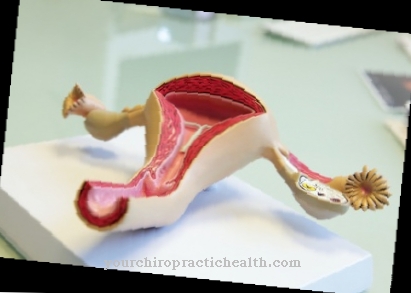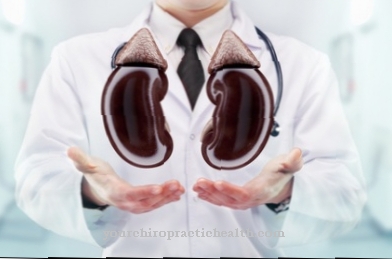As injection This is the term used to describe the parenteral administration of drugs, i.e. the administration of drugs by bypassing the intestine. The medicine is given into the skin, under the skin, into the muscle, into the vein or into the artery using a syringe.
What is the injection?

The injection is usually made using a syringe with an associated cannula. In contrast to the infusion, the drug is administered quickly. Basically, two modes of action can be distinguished in injection therapy.
On the one hand, the given drug can have a local effect. This is the case, for example, with local anesthesia. The drug is usually injected subcutaneously, i.e. into the subcutaneous fatty tissue, or at nerve endings. With intravenous and intra-arterial injection, the effect is systemic, as the drug is distributed throughout the body via the bloodstream. Injection therapy has several advantages over the oral administration of drugs. The onset of action is much faster than with oral medication.
In addition, drugs can be injected that would be broken down in the gastrointestinal tract if administered orally (e.g. insulin). In the case of orally administered agents, the dosage is often difficult because the absorption in the gastrointestinal tract varies from person to person. The first pass effect is bypassed by an injection. The first-pass effect is the metabolism of a drug in the liver, which means that when administered orally, the drug first goes through the liver metabolism before it then reaches its target site in a lower concentration. The psychological effect of an injection should also not be underestimated.
Function, effect & goals
There are mainly three types of injections used in everyday practice: subcutaneous, intramuscular and intravenous injection. With subcutaneous injection, the drug is applied to the subcutaneous tissue, i.e. the subcutis. The main injection sites are the upper arm, thigh or the region around the belly button. Since the subcutis consists mainly of fat cells, the administered agent is absorbed by the body rather slowly.
The subcutaneous injection is therefore mainly chosen for drugs that are supposed to act as a depot. An example of a subcutaneously injected preparation is insulin, which is used to treat diabetes mellitus. Heparin preparations for the prevention of thrombosis are also injected subcutaneously. Carrying out the subcutaneous injection is quite simple and with few complications. It can therefore be carried out by the patient himself without any problems after an introduction. With intramuscular injection, the drug is administered directly into the muscle.
The preferred injection sites are the gluteus medius (gluteus muscle, the vastus lateralis muscle on the thigh or the deltoid muscle on the upper arm. The Hochstetter ventrogluteal method is used to determine the correct injection site on the gluteus. With intramuscular injection, up to 20ml of a drug can be administered. The onset of action is faster than with subcutaneous injection because the muscle is better supplied with blood, but slower than with intravenous injection. Painkillers, contraceptives and cortisone preparations are mainly injected into the muscle. Vaccinations are also carried out as intramuscular injections.
For the intravenous injection, the corresponding vein must be punctured or an existing venous access must be used. The arm or neck veins are often used. The advantage of venous injection is that it takes effect quickly. In addition, larger amounts of fluid can be injected into the vein. Other types of injection that are not used so often are intra-arterial injection (into the artery), injection into the joint capsule, intracardiac injection into the heart, injection into the bone marrow, or intracutaneous injection into the dermis.
Risks, side effects & dangers
As already mentioned, the subcutaneous injection method is the least risky injection method next to the intracutaneous injection. While intramuscular injection is not difficult to perform, it should only be performed by qualified personnel as it involves some risks. It can lead to painful and sometimes irreversible nerve injuries.
The penetration of pathogens into the syringe channel is also feared. This often results in a painful injection abscess. Another risk factor is breaking the cannula in the muscle. This can happen especially in cramped patients. It is important to choose a sufficiently long cannula. Using a cannula that is too short can result in adipose tissue necrosis from accidental injection into adipose tissue. Accidental injection into a blood vessel can also have unpleasant consequences, as the drug enters the bloodstream directly in the full dose.
This is why so-called aspiration in two planes is mandatory for intramuscular injections. To do this, the syringe is stabbed into the muscle and something is aspirated to see whether blood flows into the syringe. If this is the case, the syringe is not in the muscle, but in a blood vessel. If no blood can be seen, the syringe is rotated 180 degrees and it is re-aspirated. If no blood appears in the syringe again, the drug can be injected. Patients with a tendency to bleed are an absolute contraindication for intramuscular injections.
If a blood vessel in the muscle is injured when the syringe is placed, the resulting bleeding can hardly be stopped in patients with a bleeding tendency or coagulant therapy (e.g. Marcumar). The two greatest complications of intravenous injection are paravenous, i.e. injection that runs alongside the vein, and accidental intra-arterial injection. In both cases, severe necrosis (tissue damage) can occur. In extreme cases, the affected extremity can die off completely.













.jpg)

.jpg)
.jpg)











.jpg)